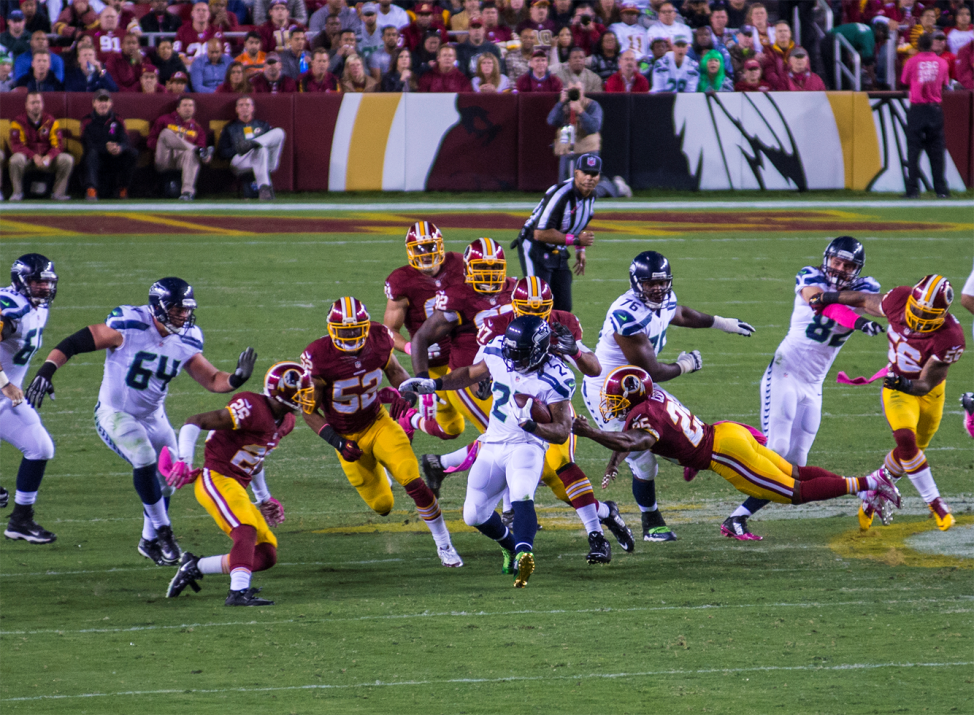
The defending team, the Washington Redskins, tries to stop the offense of the Seattle Seahawks from moving the ball down the field. (VOA / Frank Mitchell)
Enormous, well-padded warriors in helmets and vibrant, numbered jerseys, collide at high speeds on the gridiron. The sharp cracking sound of impact prompts a huge roar of approval from the large, boisterous crowd.
Millions of television viewers around the globe tune in for the games. The NFL broadcasts to more than 230 countries across six continents. Several games every season are played in or near London, England — this year at Wembley Stadium.
The noise from the impact and grunts from the players resonates across the field as rock music blasts and enormous flat screen monitors replay the action at both ends of a noisy stadium. The plays on the field are explosive, fierce and incredibly athletic – to the point where you sometimes can’t believe your eyes.
Coaches wearing headsets bark instructions, cameras wheel around, referees in black-and-white striped shirts hustle about, and rabid fans holler at the top of their lungs.
The venue is filled to capacity with about 90,000 screaming spectators clad in team garb, ball caps and jackets. Tastes run to extremes and everybody has an opinion, usually spoken loudly and with great authority – especially the shirtless guys painted in team colors from their waists to the top of their heads.
A pure American creation, professional football in the United States – as presented by the National Football League (NFL) – is a game of epic proportions. Compelling and exciting, the game is larger than life, in your face, over the top and wildly colorful. It is the king of the hill when it comes to sports in the U.S., and its appeal crosses many cultures.
The centerpiece is a ball made of pigskin with a pointed nose and circular white lines at either end, a wide middle, and five-inch laces running lengthwise down one side.
Heroes and zeroes. Winners and losers. The good, the bad, the ugly. Dudes with necks bigger than your thighs rule the landscape, commanding fame, fortune and often fleeting adulation. Professional football stars rival their Hollywood counterparts for attention and publicity. Highly lucrative product sponsorships and advertising campaigns go with the territory for the sport’s top performers.
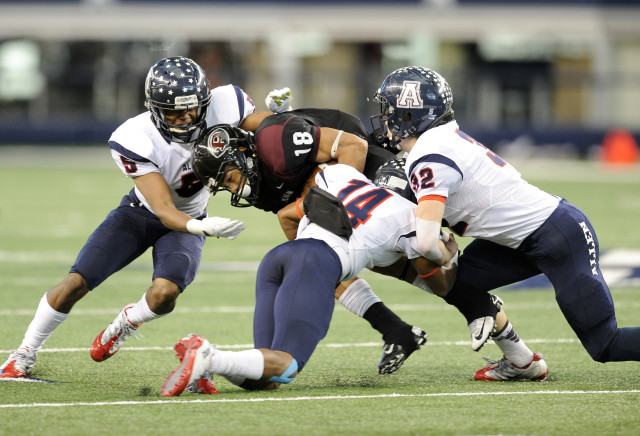
High school football contests, like this championship game played on Dec. 21, 2013, in Arlington, Texas, draw huge, enthusiastic crowds from the surrounding community. (AP Photo)
But players are only as good as their last game. Another contender is always lurking. Kids start playing in organized leagues at about six-years-old, running up through high school football, which is big time, and on to college where it’s huge. The NFL draft of college players is a whole cottage industry unto itself.
For a decade, season ticket holder Scott Sizer has had a coveted pair of seats in the end zone at FedEx Field in Landover, Maryland, overlooking the Washington Redskins sideline.
“It’s awesome to be outside with friends, eat some good food and then have fun watching the game,” said Sizer. “I like our section [in the stadium] with a lot of other fans who have become friends. It’s just great to be with everyone and cheer for our team, even when they lose.”
Broadcasting bonanza
All of the games are broadcast on network television. There are pre-game shows, post-game analysis programs and a 24-7 NFL network dedicated solely to the sport. Fans and advertisers can’t seem to get enough.
It’s a year-round enterprise, even though the season itself begins in August with pre-season games, rolls into the regular season, and concludes in early February with the Super Bowl (no explanation necessary).
The winner of this ultimate championship game is crowned world champion and awarded the coveted Lombardi trophy, named after legendary coach Vince Lombardi, who led his team to 13 championships.
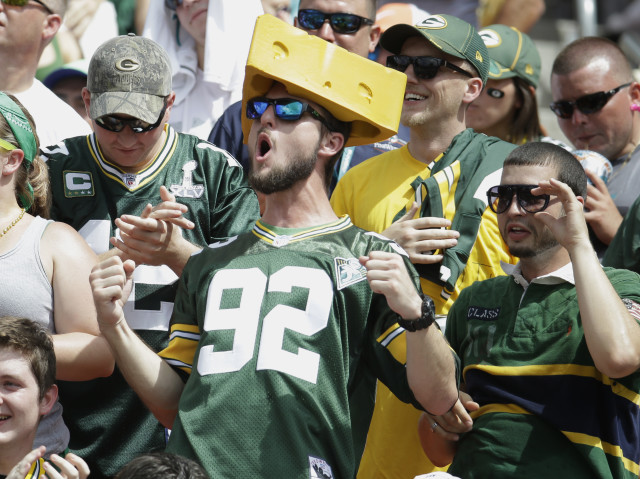
Green Bay Packers fans cheer during an NFL football game against the Miami Dolphins, Oct. 12, 2014, in Miami Gardens, Fla. (AP Photo)
In this day of giant, flat-screen, high-definition TVs, many aficionados find the viewing experience at home to be even better than watching the action live on the field. True fans might not agree, but it’s tough to beat the view you get on a TV set, with replays, announcers, analysis and the comfort of your own home.
Rules of the game
Rules of the game are elaborate and intricate. On a basic level, though, it boils down in a straightforward way.
It’s offense versus defense. There are eleven players from each team on the field at any given time. The team with the ball is on the offensive, and tries to move the ball down the field by running with it or throwing it. Points are scored when the offense crosses the goal line at the end of the field, an area called the end zone. When on defense, the opposing team attempts to prevent the offense from scoring.
Injuries are an unavoidable part of this exceptionally physical game. Every team has them, but too many, or a few key ones, can torpedo a team’s chances – unless it has depth, in the form of able backup players who can step up and fill the void.
Multiple players suffer injuries every week, and dozens of others get the “bumps and bruises” that are part of the game. The Injured Reserve list is watched closely by fans, gamblers and participants in so-called fantasy leagues.
Large revenues
Sure, it’s over the top, it’s also worth billions of dollars in television broadcasting rights, advertising revenue, merchandising partnerships, ticket sales, player endorsements, and stadium deals.
The NFL made $10.5 billion last year, according to various estimates, and that could be on the low side. Some reports say the league hopes revenue will hit $25 billion by 2027. Given the level of national interest, that doesn’t seem like a stretch.
Pre-game fun
Intrinsic rituals associated with the sport include tailgating, when fans arrive many hours before the game and begin the party early in the stadium parking lobby, eating and drinking copious amounts of food and drink.
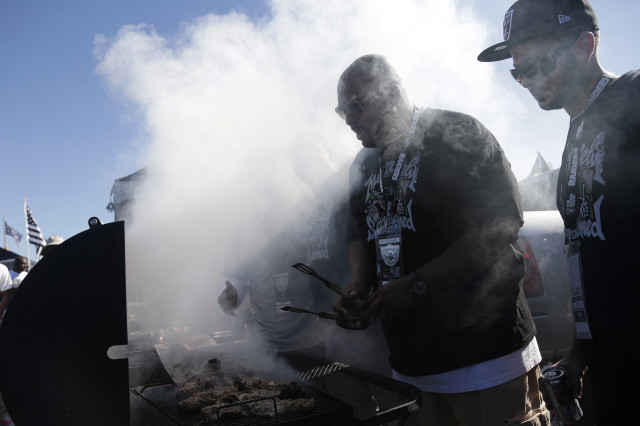
Oakland Raiders fans grill while tailgating in the stadium parking lot before an NFL football game between the Raiders and the San Diego Chargers in Oakland, Calif., Oct. 12, 2014. (AP Photo)
The team’s flags are flying, grills are smoking, sandwiches are being scarfed down, and alcoholic liquid libations – especially beer – are consumed.
Fleets of enormous recreation vehicles, often embellished with the team colors and logo crowd the parking lot. They have large TV screens, radio broadcasts blaring and music.
Longtime Washington Redskins fans Amy Stevens and her husband, Greg, of Germantown, Maryland, sat behind their car with the back trunk open in the parking lot at Fedex Field on a beautiful fall Sunday afternoon. They consumed sandwiches, chips, other munchies and cold beer.
With their young children at home with family, the games are a great escape.
“There’s a lot of energy, excitement and camaraderie,” said Greg. “There’s a real sense of community, and there’s always hope that they can win today. Football is such a tremendous sport and there often are surprises.”
Once the game begins, cheerleaders vamp, beer vendors hustle up and down the steep aisles hawking cold beers, peanuts and other refreshments at premium prices. Concession stands that ring the stadium’s promenade levels sell hot dogs, soda, pretzels, pizza, popcorn and more.
Games are an expensive proposition; tickets range from $80 each for the cheap seats to several hundred dollars for the good ones. Then there’s the additional cost of parking, food, drink and memorabilia.
By the numbers
Gambling is huge in football. Billions of dollars are wagered weekly on the games.
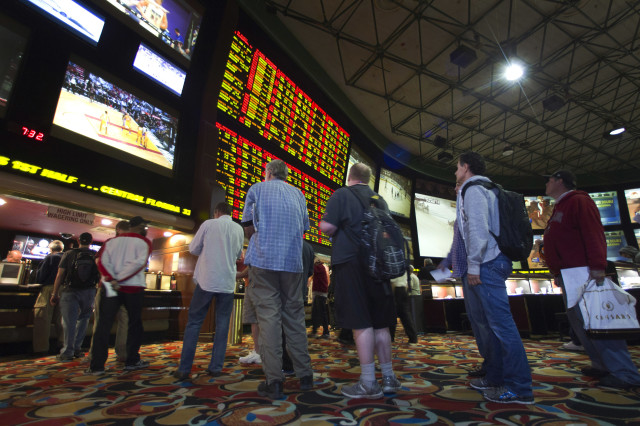
People wait in line to place bets on Super Bowl XLVIII at the Las Vegas Hotel & Casino Superbook in Las Vegas, Nevada Jan. 23, 2014.
Betting is legal in Las Vegas, where the sharpies – computer-assisted number crunchers — pore through minutia to determine razor-sharp margins. Points are given to the underdogs to encourage maximum wagering.
In the informal football fantasy leagues across the county, participants create their own teams by drafting players from various real teams, who then take on other dream teams. The fantasy leagues are run by colleagues, friends and family members.
And while football is a uniquely American obsession at the moment, that might not be the case for much longer. The league has featured exhibition games in European cites for several years now, and there’s talk of expanding the league beyond U.S. shores.
A play like that could be a big score for the NFL, while lending even more substance to the title of “Super Bowl World Champions”.






















The headline appears to be intended to insult most of the sports fans in the world. That is unfortunate because I enjoy watching NFL football almost as much as I enjoy watching the beautiful game. I used to enjoy the NFL game a lot more than I do now but that may be due to the onset of curmudgeonisticy due to my advancing age. The only thing that the two games have in common is the linguistic structure of the name, the number of teams, the number of players and the difficulty the officials have in judging whether play conforms to the rules.
The NFL game is a game of specialists and depends on the seamless teamwork between these specialists. There is a lot of complexity and it can only be understood in depth by one who has played the game seriously. My son played for many years and was able to follow the league from his teaching post in China better than I can with my fibre-optic HD Television and instant access to the NFL Channel. There are nuances in every situation from offensive and defensive viewpoints that still escape me after nearly fifty years as a fan.
The FIFA game is as simple as possible, requiring almost no equipment beyond a ball, a number of boys (or girls) and a flat bit of ground. The teams are basically equal and play may switch instantly between attack and defense. It is the skill of the players that determines the outcome of this game whereas the NFL game often swings on the ability of coaching staff to analyze play and adjust to the particulars of play in comparison to the historical performance of an opponent.
Both games have a rich history whether that be Maradona’s ‘Hand of God’ or Franco Harris’ “Immaculate Reception” .
Soccer is much more popular worldwide yet you ignore this with such an ignorant title to a rather simplistic article. Typical of a jock,not a real journalist.
An unfortunate title. Please excuse my use of language – I hate the word ‘soccer’ (childish) and so I refer to soccer as football.
I too enjoy both the NFL and the ‘World Game’. They are two very different sports, both with their flaws and their positives. There is a very rich history and tradition to ‘football’ (soccer) that the American psyche will never understand. ‘Sports fans’ attend NFL games and follow the league with passion whereas there is a much deeper connection to ‘football’ (soccer) in Europe – there you have Ultras (violent militant fans), fans that would die for their respective club, fans that simply exsit for their team and for no other purpose – you will never see that level of passion during an NFL match with its hotdogs and familial altmosphere. The hate that exists between fans when Chelsea plays Liverpool for example bridges cultural, demographic and social contexts; it’s a genuine hate, a genuine passion. No NFL fans really hate each other with such fervour, if at all.
However, the professionalism that is the NFL is quite awe inspiring. Football(soccer) lacks the detail in its analysis that it should have, Football seems to analyse its plays esoterically, whereby only those that play the game understand the true context. The NFL is different – the commentators bring the fans into its analyses and tries to perpetually eduacte and intellectualise the sport – an attractive aspect of the game. NFL also seems to have a better structure to its leage vis a vis those in European football. Ironically, its a completely communist system – salary capped – giving each teams an equal chance. It’s totally different in football – a few ‘elite clubs’ rule the game – the rest struggle – I don’t think this is an attractive set-up and I don’t think it would work in America where ‘frachise loyalty’ is probably a lot less than club loyalty in Europe where your virtually born into your club at birth and if working class have a tatoo expressing that loyalty by the time you turn 21.
All in all, two magnificent sports but I lament the fact that they are compared – we should take a leaf out of Seattle’s book, sports fans there seem to be able to enjoy both.
American football borrowed a lot of ideas from rugby. The NFL may be very popular in North America but it has only a fraction of the worldwide audience that rugby has.
great statement. rugby rules and the nfl is small potatoes when you compare the enthusiasm of the players and the true fans of a great sport!
Ron, can you please tell me, the main differences between Rugby and Fantasy Football ??
I don’t think the person who wrote the title read the article, which was informative and generally well-written and never once mentions “soccer” (which coincidentally is what my grandfather called it, reserving the title “football” for Rugby Football).
Silly, silly, clickbait headline. You should be ashamed of yourself!
To add insult to idiocy, the article includes the Washington franchise which refuses to change the name in spite of widespread objection. They aren’t even a historically significant team like the Green Bay Packers, New York Giants and the (yech) Dallas Cowboys.
There are only 196 countries in the world so this doesn’t make sense, “The NFL broadcasts to more than 230 countries”.
Actually, I like football but didn’t have much knowledge about this Fantasy Football. So can you please explain in detail.?? Anyone??